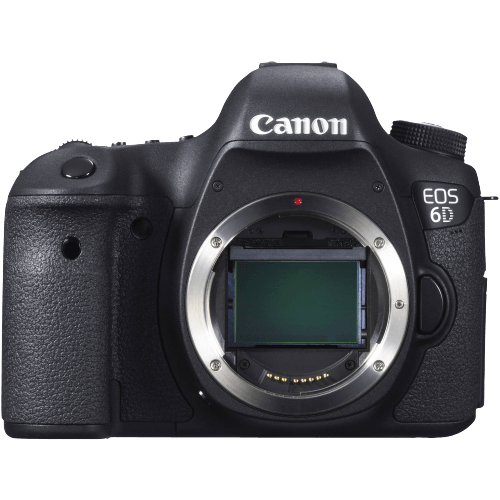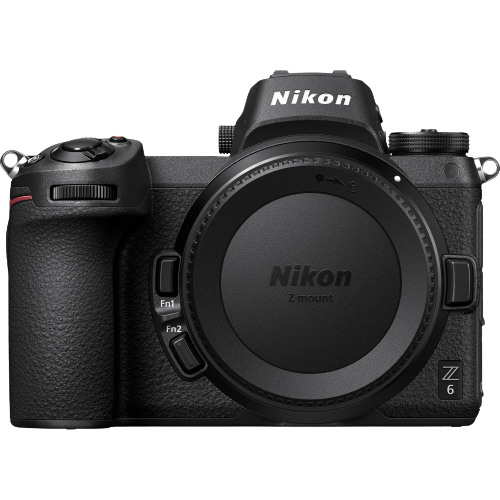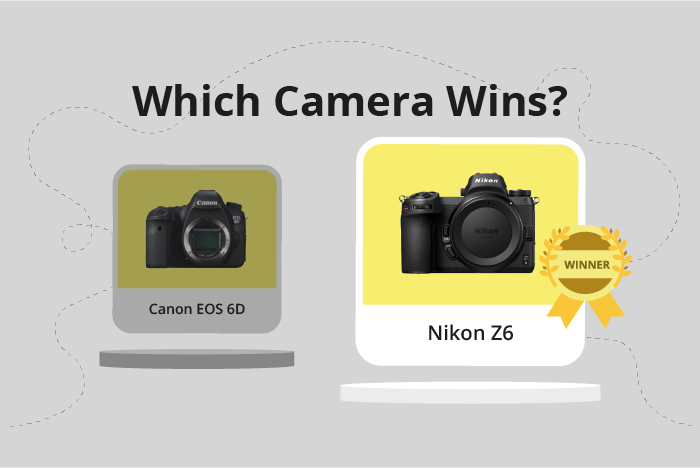Canon EOS 6D vs Nikon Z6 Comparison
Canon EOS 6D

Nikon Z6

The Nikon Z6 is the winner in this comparison, scoring 81/100, while the Canon EOS 6D received a score of 59/100. Both cameras were launched at a similar price, with the Canon EOS 6D at $2099 and the Nikon Z6 at $2000. They also have a similar size and weight, with the Canon EOS 6D measuring 145 x 111 x 71mm and weighing 770g, while the Nikon Z6 measures 134 x 101 x 68mm and weighs 675g.
The Nikon Z6 outshines the Canon EOS 6D due to its mirrorless design, which allows for a more compact and lighter camera. Additionally, the Nikon Z6 was released in 2018, making it more technologically advanced than the Canon EOS 6D, which was released in 2012.
On the other hand, the Canon EOS 6D, being a DSLR, may appeal to those who prefer a more traditional camera design. However, this does not make up for the significant difference in scores.
In the end, the Nikon Z6 is the better choice due to its higher score, modern design, and lighter weight. The Canon EOS 6D, while still a decent option, falls short in comparison.
Canon EOS 6D vs Nikon Z6 Overview and Optics
The Nikon Z6 outperforms the Canon EOS 6D in optics with a score of 83/100 compared to 61/100. Both cameras share some specifications, including a CMOS sensor type, full-frame sensor size, and similar lens mounts – the Nikon Z6 uses a Nikon Z mount, while the Canon EOS 6D uses a Canon EF mount.
The Nikon Z6’s superiority in optics is evident in its higher megapixel count of 24.5, compared to the Canon EOS 6D’s 20.2 megapixels. This allows the Nikon Z6 to capture more detail and better image quality. Furthermore, the Nikon Z6 boasts a faster shooting speed of 12 fps, as opposed to the Canon EOS 6D’s 4.5 fps, enabling it to capture fast-moving subjects more effectively. The Nikon Z6’s Expeed 6 processor and a DXOMARK sensor score of 95 also contribute to its superior performance. Additionally, the Nikon Z6 features image stabilization, which the Canon EOS 6D lacks, making it more suitable for handheld photography.
The Canon EOS 6D’s advantages are limited in comparison to the Nikon Z6. Its Digic 5+ processor and a DXOMARK sensor score of 82 are lower than the Nikon Z6’s specifications, which results in a less impressive performance in terms of image quality and processing speed.
Considering these factors, the Nikon Z6 is the clear winner in optics, offering better image quality, faster shooting speeds, and image stabilization. The Canon EOS 6D, on the other hand, falls short in most aspects when compared to the Nikon Z6.
Canon EOS 6D vs Nikon Z6 Video Performance
The Nikon Z6 takes the lead in video capabilities with a score of 83/100, compared to the Canon EOS 6D’s score of 43/100. Both cameras share some common video specifications, such as recording in H.264 format and offering manual exposure control. However, the Nikon Z6 outperforms the Canon EOS 6D in several key areas.
One major advantage of the Nikon Z6 is its 4K video resolution (3840 x 2160), which is significantly higher than the Canon EOS 6D’s Full HD resolution (1920 x 1080). This allows the Nikon Z6 to produce sharper and more detailed videos. Additionally, the Nikon Z6 offers a higher maximum video frame rate of 60fps, compared to the Canon EOS 6D’s 30fps. This means the Nikon Z6 can capture smoother slow-motion footage and provide more flexibility in post-production.
The Nikon Z6 also has time-lapse functionality built in, while the Canon EOS 6D does not. This feature allows the Nikon Z6 to create stunning time-lapse videos without the need for additional equipment or software.
On the other hand, the Canon EOS 6D has a slightly larger sensor size, which can potentially provide better low-light performance and a shallower depth of field. However, this advantage is not significant enough to offset the Nikon Z6’s superior video specifications.
Considering these factors, the Nikon Z6 clearly outshines the Canon EOS 6D in terms of video capabilities. The 4K resolution, higher frame rate, and built-in time-lapse functionality make the Nikon Z6 a more versatile and powerful choice for videographers. While the Canon EOS 6D does have a larger sensor size, it falls short in other important aspects, making the Nikon Z6 the superior option for video recording.
Canon EOS 6D vs Nikon Z6 Features and Benefits
The Nikon Z6 is the winner in the features comparison with a score of 87/100, while the Canon EOS 6D scores 57/100. Both cameras share some specifications, such as having a 3-inch screen, lacking a flip screen, and including WIFI connectivity.
The Nikon Z6 outperforms the Canon EOS 6D in several aspects. It has a larger 3.2-inch screen, offering more comfortable image review and menu navigation. The screen resolution of the Nikon Z6 is also higher at 2,100,000 dots, compared to the Canon EOS 6D’s 1,040,000 dots, providing a clearer and sharper display. Additionally, the Nikon Z6 features a touchscreen, making it easier to navigate menus and change settings quickly. The Z6 also includes Bluetooth connectivity, enabling seamless pairing with compatible devices for photo sharing and remote camera control.
In contrast, the Canon EOS 6D has a unique advantage over the Nikon Z6: it features built-in GPS. This allows photographers to geotag their images, which can be useful for travel photography or documentation purposes.
Considering the differences in features, the Nikon Z6 is the superior camera in this comparison due to its larger and higher-resolution touchscreen, as well as its Bluetooth connectivity. The Canon EOS 6D’s built-in GPS is a valuable feature for specific use cases, but it does not outweigh the advantages offered by the Nikon Z6. As a result, the Nikon Z6 is the better choice for photographers seeking a camera with more advanced and user-friendly features.
Canon EOS 6D vs Nikon Z6 Storage and Battery
The Canon EOS 6D outperforms the Nikon Z6 in storage and battery with a score of 45/100 compared to 35/100. Both cameras have a single memory card slot, but the Canon EOS 6D accepts SD / SDHC / SDXC cards, whereas the Nikon Z6 uses XQD cards. The EOS 6D’s battery life is significantly better, offering 1090 shots per charge using its LP-E6 battery, while the Z6’s EN-EL15b battery provides only 310 shots.
The Canon EOS 6D’s longer battery life makes it more suitable for extended shooting sessions. On the other hand, the Nikon Z6 has the advantage of USB charging, allowing users to easily recharge the battery on the go.
Considering the storage and battery aspects, the Canon EOS 6D proves to be more reliable and versatile, while the Nikon Z6 offers the convenience of USB charging.
Canon EOS 6D vs Nikon Z6 – Our Verdict
Are you still undecided about which camera is right for you? Have a look at these popular comparisons that feature the Canon EOS 6D or the Nikon Z6:

